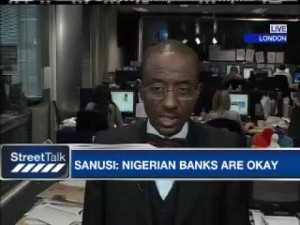Bank recovery fails to reach real economy
 The recovery of Nigeria’s banking sector has failed to get credit flowing to the real economy, as high interest rates and a liquidity squeeze funnel money away from businesses or consumers into high yielding government debt, market players say.
The recovery of Nigeria’s banking sector has failed to get credit flowing to the real economy, as high interest rates and a liquidity squeeze funnel money away from businesses or consumers into high yielding government debt, market players say.
Three years after a credit crisis led to the near collapse of nine lenders, banking capital ratios have recovered, but lenders are piling all their cash into treasury bills at yields that are unlikely to be sustainable, say banking analysts.
Yields have already fallen in the past month, as JP Morgan prepares to include Nigeria’s debt in one of its indices.
“Eventually banks are going to have to take real economy risks to drive up returns. I can’t imagine that regulators will continue to licence the operation of banks … without there being evidence of some lending to the real sector,” said Razia Khan, head of Africa research at Standard Chartered Bank.
Nigeria’s economy grew 6.17 percent in the first quarter of this year, according to the latest available figures, but credit to the private sector grew just 4.3 percent by July 2012, while lending to the government shot up 56.5 percent in that time.
Interest income now accounts for 50-70 percent of gross earnings for Nigerian banks, Francis Ikenga, head of strategy at Fidelity Bank told Reuters, but it is mostly in government debt.
“Interest rates and lending criteria are too difficult to meet,” Lagos household product saleswoman Titi Adeojo said recently. “We do a lot of deposits (but) it’s not easy to get a loan”.
STARVED OF CREDIT
In 2008, credit to the private sector outstripped government borrowing for the first time in Nigeria, a move which many analysts had thought heralded a consumer driven boom.
But 6.3 percent of a total loans of 7.4 trillion naira ($47 bln) granted in 2008 turned bad, Renaissance Capital says, leaving nine overleveraged banks in need of a bailout.
Banks are reluctant to risk burning their fingers again.
“Our lending pattern has changed as it is more skewed towards major corporates. Our approval processes … is now more stringent,” said Kayode Fadahunsi, investor relations director at top lender United Bank for Africa.
Banks worry consumers and firms may not be able to pay back loans at high interest rates, whereas tax free government bond returns are a safe bet at such attractive rates of 15-16 percent — a huge spread over average bank deposit rates of 1-2 percent.
“Access to credit is a bit more difficult for the businesses and households,” said Femi Aribaloye, head of risk management at Skye Bank. He said lending rates for big firms like Flour Mills have risen to 14 percent this year, from 12 percent in 2008. For consumers, by contrast, they went up to 33 percent this year, from 22 percent last year.
“The crisis in the industry seems to be over,” he said. “But investments are largely being channeled to safer outlets.”
Yet if treasury yields continue to fall, banks over-reliance on them for earnings could hurt profitability down the line.
Source: Reuters








